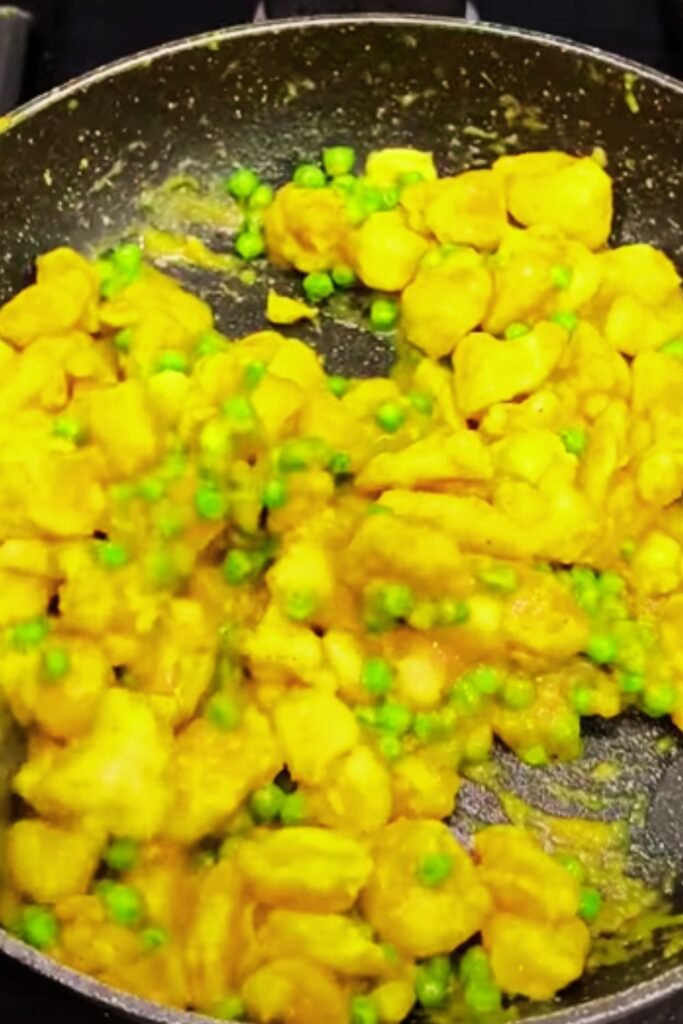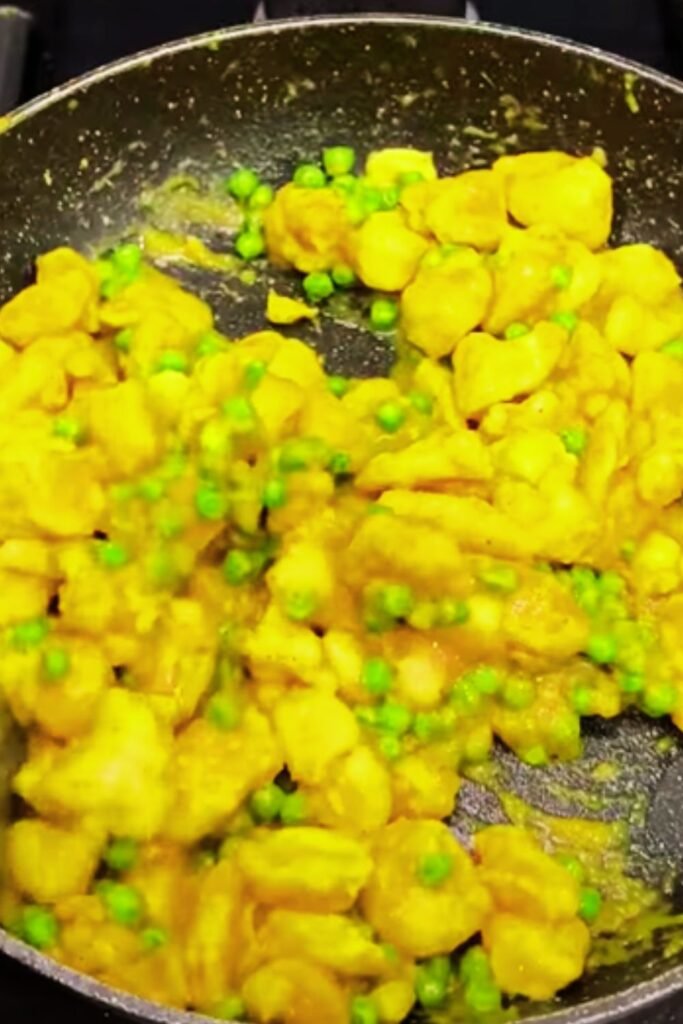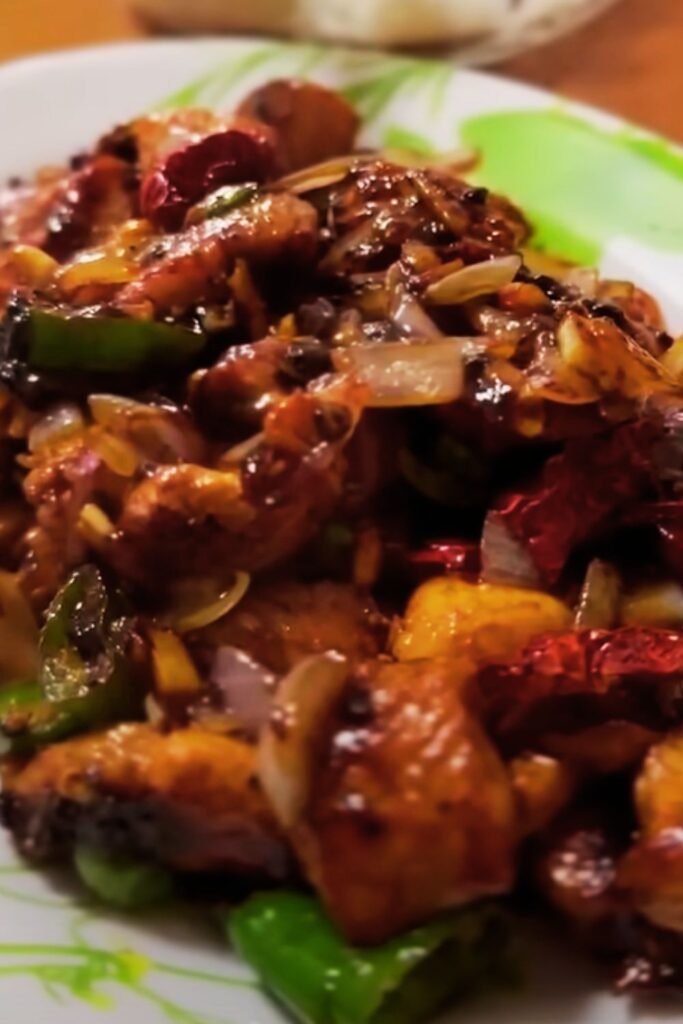When I first discovered Chinese chicken curry, I was amazed by how different it tasted from the Indian curries I was accustomed to. This dish represents a beautiful fusion of Chinese cooking techniques with curry flavors, creating something uniquely delicious and surprisingly slimming-friendly. My journey with this recipe began during my quest to find healthier takeaway alternatives that didn’t compromise on flavor.
Chinese chicken curry offers a lighter, more delicate approach to curry-making. Unlike its heavier counterparts, this version focuses on fresh ingredients, minimal oil, and a sauce that’s both flavorful and figure-friendly. I’ve spent years perfecting this recipe, and today I’m sharing every secret I’ve learned along the way.
What Makes Chinese Chicken Curry Special
Chinese chicken curry stands apart from other curry varieties in several fascinating ways. The sauce tends to be lighter and less coconut-heavy than Thai curries, while being less spice-intense than many Indian versions. What I love most about this dish is how it achieves incredible depth of flavor without relying on heavy creams or excessive oils.
The cooking technique itself is distinctly Chinese, employing the principle of “wok hei” – the breath of the wok. This means cooking at high heat for short periods, which helps vegetables retain their crunch and chicken stay tender. The result is a curry that feels fresh and vibrant rather than heavy and sluggish.
Key Characteristics:
- Light sauce consistency – Not thick like many Western curries
- Fresh vegetable emphasis – Vegetables maintain their texture and color
- Balanced spice level – Warm and fragrant without overwhelming heat
- Quick cooking method – Preserves nutrients and flavors
- Lower calorie profile – Perfect for weight management goals
Essential Ingredients Breakdown
Understanding each ingredient’s role has helped me create the perfect balance every time I make this dish. Let me walk you through the essential components:
Protein Component: The chicken forms the heart of this dish. I prefer using boneless, skinless chicken thighs because they remain juicy during the quick cooking process. However, chicken breast works beautifully for those watching their fat intake more closely.
Aromatic Base: Ginger, garlic, and onions create the foundation of flavor. I always use fresh ginger – the difference in taste is remarkable compared to powdered versions. The onions should be cut into chunky pieces to maintain texture.
Curry Powder Selection: Not all curry powders are created equal. I’ve found that Chinese curry powder tends to be milder and more aromatic than Indian versions. If you can’t find Chinese curry powder specifically, a mild Madras curry powder works well.
Vegetable Medley: Bell peppers, carrots, and potatoes are traditional, but I’ve experimented with additions like snow peas, baby corn, and water chestnuts. Each adds its own texture and nutritional benefits.

Detailed Nutritional Information
Understanding the nutritional profile helps me feel confident about serving this regularly to my family. Here’s a comprehensive breakdown:
| Nutrient | Per Serving (4 servings total) | Daily Value % |
|---|---|---|
| Calories | 285 | 14% |
| Total Fat | 8.5g | 11% |
| Saturated Fat | 2.1g | 11% |
| Cholesterol | 75mg | 25% |
| Sodium | 520mg | 23% |
| Total Carbohydrates | 24g | 9% |
| Dietary Fiber | 4.2g | 15% |
| Sugars | 8g | – |
| Protein | 28g | 56% |
| Vitamin A | 2,850 IU | 57% |
| Vitamin C | 85mg | 94% |
| Calcium | 45mg | 4% |
| Iron | 2.8mg | 16% |
Ingredient Substitutions and Variations
Over the years, I’ve discovered numerous ways to adapt this recipe for different dietary needs and preferences:
For Lower Carb Versions:
- Replace potatoes with cauliflower florets
- Use zucchini or daikon radish as potato substitutes
- Increase the protein portion and reduce vegetables
For Vegetarian Adaptations:
- Substitute chicken with firm tofu or tempeh
- Add extra vegetables like eggplant or mushrooms
- Use vegetable stock instead of chicken stock
Spice Level Adjustments:
- Add fresh chilies for more heat
- Include a teaspoon of chili garlic sauce
- Use hot curry powder instead of mild
Protein Alternatives:
- Turkey breast works wonderfully
- Firm white fish like cod or halibut
- Prawns or shrimp for a seafood version
Step-by-Step Cooking Method
My approach to this recipe ensures consistent results every time. The key is preparation – having everything ready before you start cooking.
Preparation Phase: I begin by cutting all ingredients to uniform sizes. This ensures even cooking and professional presentation. The chicken should be cut into bite-sized pieces, about 1-inch cubes. Vegetables need to be prepared according to their cooking times – harder vegetables like carrots cut smaller, softer ones like bell peppers in larger pieces.
The Marinade Process: Marinating the chicken, even briefly, makes a tremendous difference. I combine soy sauce, rice wine, and cornstarch to create a light coating that helps the chicken stay tender and helps the sauce adhere better.
Cooking Sequence: The order of cooking is crucial. I start with the aromatics – ginger and garlic – in a small amount of oil. The fragrance that fills the kitchen at this stage is incredible. Next comes the chicken, which I cook until just done but still tender.
Vegetable Integration: Adding vegetables in stages based on their cooking times ensures everything finishes perfectly. Carrots and potatoes go in first, followed by onions, and finally bell peppers.
Sauce Development: The sauce comes together quickly once you add the curry powder and liquid components. I’ve learned that letting it simmer just long enough to thicken slightly creates the perfect consistency.

Advanced Cooking Tips and Techniques
Through trial and error, I’ve discovered several techniques that elevate this dish from good to extraordinary:
Temperature Control: Maintaining high heat throughout most of the cooking process is essential. This creates the characteristic “wok hei” flavor and prevents vegetables from becoming mushy. However, I reduce the heat when adding the curry powder to prevent burning.
Sauce Consistency Management: The sauce should coat the ingredients lightly without being too thick or too thin. I’ve found that the cornstarch slurry technique works best – mixing cornstarch with cold water before adding to the pan prevents lumps.
Flavor Layering: Building flavors in layers creates complexity. I bloom the curry powder briefly in the oil before adding liquids, which intensifies its flavor significantly.
Timing Precision: This dish cooks quickly, so timing is everything. I have all ingredients prepped and within arm’s reach before I start cooking. The entire cooking process takes less than 15 minutes once you begin.
Comprehensive Recipe
Ingredients:
- 1.5 lbs boneless chicken (thighs or breast), cut into 1-inch pieces
- 2 tablespoons vegetable oil, divided
- 1 large onion, cut into wedges
- 3 cloves garlic, minced
- 1 tablespoon fresh ginger, minced
- 2 tablespoons Chinese curry powder
- 1 large bell pepper, cut into strips
- 2 medium carrots, sliced diagonally
- 2 medium potatoes, cubed
- 1 cup chicken stock
- 2 tablespoons light soy sauce
- 1 tablespoon oyster sauce
- 1 teaspoon sugar
- 2 tablespoons cornstarch mixed with 3 tablespoons water
- 2 green onions, chopped
- Salt and white pepper to taste
For the Marinade:
- 1 tablespoon light soy sauce
- 1 tablespoon rice wine or dry sherry
- 1 teaspoon cornstarch
Method:
- Prepare the chicken: Mix chicken pieces with marinade ingredients and let stand for 15 minutes while you prepare other ingredients.
- Heat the wok: Heat 1 tablespoon oil in a large wok or skillet over high heat until almost smoking.
- Cook the chicken: Add marinated chicken and stir-fry for 3-4 minutes until just cooked through. Remove and set aside.
- Build the aromatic base: Add remaining oil to the wok. Add ginger and garlic, stir-fry for 30 seconds until fragrant.
- Add vegetables: Add potatoes and carrots first, stir-fry for 2 minutes. Add onion wedges and cook for another minute.
- Bloom the curry powder: Push vegetables to one side of the wok, add curry powder to the empty space and stir for 15 seconds until fragrant.
- Create the sauce: Add chicken stock, soy sauce, oyster sauce, and sugar. Bring to a boil.
- Simmer and thicken: Reduce heat to medium, cover and simmer for 5-7 minutes until potatoes are tender.
- Final assembly: Return chicken to the wok, add bell peppers and cornstarch slurry. Stir until sauce thickens slightly.
- Finish and serve: Season with salt and white pepper, garnish with green onions.
Slimming Benefits and Health Advantages
What makes this recipe particularly suitable for weight management goals goes beyond just calorie counting. The combination of lean protein, fiber-rich vegetables, and minimal added fats creates a satisfying meal that supports healthy eating habits.
Protein Power: With 28 grams of protein per serving, this dish helps maintain muscle mass during weight loss and keeps you feeling satisfied longer. The high protein content also has a thermic effect, meaning your body burns calories digesting it.
Fiber Content: The vegetables provide substantial fiber, which aids digestion and helps you feel full with fewer calories. This natural satiety factor is crucial for long-term weight management success.
Nutrient Density: Unlike many takeaway versions loaded with empty calories, this homemade version delivers significant vitamins A and C, supporting immune function and skin health during your weight loss journey.
Portion Control Friendly: The combination of protein and vegetables naturally creates appropriate portion sizes without leaving you feeling deprived.

Storage and Meal Prep Strategies
I’ve found this recipe incredibly meal-prep friendly, which has been a game-changer for my busy weekdays:
Refrigerator Storage: The curry keeps beautifully in the refrigerator for up to 4 days. I store it in glass containers, which don’t absorb flavors and reheat evenly.
Freezing Guidelines: While the dish can be frozen for up to 3 months, I recommend slightly undercooking the vegetables if you plan to freeze, as they’ll continue cooking during the reheating process.
Reheating Best Practices: I prefer reheating on the stovetop with a splash of water or stock to refresh the sauce. Microwave reheating works but requires stirring halfway through to ensure even heating.
Batch Cooking Tips: This recipe doubles and triples easily. I often make a large batch on Sundays and portion it into individual containers for the week ahead.
Serving Suggestions and Pairings
The versatility of Chinese chicken curry makes it suitable for various serving styles:
Traditional Pairings: Steamed jasmine rice remains the classic accompaniment, but I often opt for cauliflower rice to keep the carb content lower. Brown rice adds fiber and nutrients while maintaining the traditional feel.
Low-Carb Options: Shirataki noodles or zucchini noodles work wonderfully for those avoiding grains entirely. The sauce coats these alternatives beautifully.
Complete Meal Additions: A simple side of steamed bok choy or Chinese broccoli adds extra vegetables and authentic flavor. Light spring rolls made with rice paper and fresh vegetables complement the meal nicely.
Garnish Ideas: Fresh cilantro, sliced chilies, or a squeeze of lime can brighten the flavors. Toasted sesame seeds add a nice textural contrast.
Troubleshooting Common Issues
Through my experience making this dish countless times, I’ve encountered and solved several common problems:
Sauce Too Thin: If your sauce isn’t thickening properly, make sure your cornstarch slurry is fresh and well-mixed. Add it gradually while stirring constantly. Sometimes the heat isn’t high enough for proper thickening.
Vegetables Overcooked: This usually happens when the heat is too low or cooking time is too long. Maintain high heat and add vegetables in stages based on their cooking requirements.
Lack of Flavor: Underseasoned dishes often result from not blooming the curry powder properly or using old spices. Always bloom spices in oil and taste for seasoning at the end.
Chicken Tough: Overcooking causes tough chicken. Remove it from the wok as soon as it’s cooked through, then return it briefly at the end just to heat through.
Cultural Context and History
Understanding the background of Chinese chicken curry has deepened my appreciation for this dish. It represents the beautiful evolution of Chinese cuisine as it adapted to different regions and available ingredients.
This style of curry likely developed in Chinese communities outside of mainland China, where local ingredients and preferences influenced traditional Chinese cooking methods. The result is a unique fusion that maintains Chinese cooking principles while embracing curry flavors.
The dish exemplifies the Chinese cooking philosophy of balance – balancing flavors, textures, and colors in a single dish. This principle guides every decision I make when preparing it, from ingredient selection to final presentation.
Frequently Asked Questions
Q: Can I make this curry ahead of time? Yes, this curry actually improves in flavor when made ahead. I often prepare it the day before serving, as the flavors have time to meld beautifully. Just reheat gently and add a splash of stock if needed.
Q: What’s the best substitute for Chinese curry powder? Mild Madras curry powder works well, or you can create your own blend using turmeric, coriander, cumin, and a small amount of garam masala. The key is keeping it mild and aromatic rather than fiery hot.
Q: How can I make this dish spicier? Add fresh sliced chilies with the ginger and garlic, include a teaspoon of chili garlic sauce, or use hot curry powder instead of mild. You can also serve with chili oil on the side for individual preference.
Q: Is it possible to make this in a slow cooker? While possible, you’ll lose the characteristic texture that comes from wok cooking. If using a slow cooker, sear the chicken first, add harder vegetables and liquid, cook on low for 4-6 hours, then add softer vegetables in the last hour.
Q: Can I use frozen vegetables? Fresh vegetables provide the best texture and flavor, but frozen can work in a pinch. Thaw and drain them thoroughly first, and add them later in the cooking process since they’ll cook faster.
Q: What type of potatoes work best? Waxy potatoes like Yukon Gold hold their shape better during cooking. Avoid russet potatoes as they tend to break down too much in the sauce.
Q: How do I prevent the sauce from separating? Make sure your cornstarch slurry is well-mixed and add it while stirring constantly. Don’t let the sauce boil vigorously after adding the slurry, as this can cause separation.
Q: Can I double this recipe easily? Yes, this recipe doubles well. Just make sure your wok or pan is large enough to accommodate everything without overcrowding, which would cause steaming instead of stir-frying.
Q: What’s the difference between light and dark soy sauce in this recipe? Light soy sauce provides saltiness and umami without darkening the dish significantly. Dark soy sauce would make the curry much darker and slightly sweeter, changing the traditional appearance and flavor profile.
Q: How long should I marinate the chicken? Even 15 minutes makes a difference, but you can marinate for up to 2 hours for maximum flavor. Beyond that, the acid in the marinade can start to change the chicken’s texture.
This Chinese chicken curry has become one of my go-to recipes for healthy, satisfying meals that don’t compromise on flavor. The combination of tender chicken, crisp vegetables, and aromatic sauce creates a dish that feels indulgent while supporting my health goals. Whether you’re new to Chinese cooking or looking for a lighter curry option, this recipe delivers on all fronts – flavor, nutrition, and satisfaction.